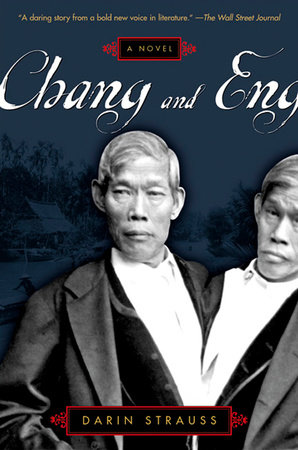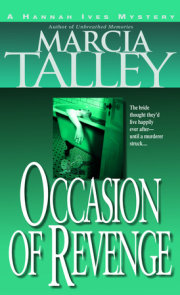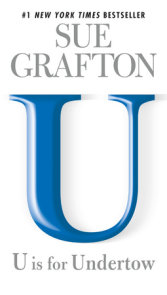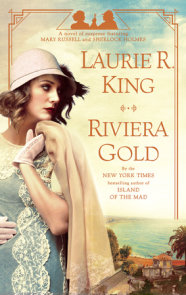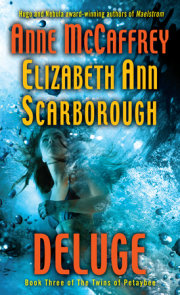READERS GUIDE
Questions and Topics for Discussion
INTRODUCTION
This much is known: Conjoined twins attached at the chest, Chang and Eng Bunker were born in poverty in Siam, were taken abroad and displayed as a human curiosity by an unscrupulous promoter, and with the help of P.T. Barnum, gained control of their professional lives as entertainers. In their early thirties, the two moved to North Carolina, married sister Adelaide and Sarah Yates, and between them, fathered 21 children. On January 17, 1874, first Chang, then Eng Bunker passed away.
From this fertile base of reality, first-time novelist Darin Strauss imagines the lives of Chang and Eng otherwise lost to history and myth. The product of three years of intensive research, Chang and Eng is the story of the two told by Eng on his deathbed as he remembers his life, his conjoined twin lifeless beside him. A story of union in the face of adversity, it follows the extraordinary lives of the twins from poverty to wealth, from hopeless solitude to boundless love, from the court of the King of Siam to the crowded bedroom of their North Carolina home. Grand in scope, vivid in detail, and sublimely moving, Chang and Eng is a story that reveals the longing and humanity of two very different men who exited this world as they entered it—bonded together by common flesh.
ABOUT DARIN STRAUSS
Darin Strauss is a graduate of the New York University creative writing program in fiction. His writing has appeared in GQ, Time Out, and literary journals, among other publications.
Praise
“This summer’s successor to Memoirs of a Geisha.”–The Wall Street Journal
“This exquisitely written, heartbreaking, brilliant first novel tells the fictionalized story of real-life conjoined twins Chang and Eng. . . . This is a lush work, sumptuous in detail, with stunning imagery and superb characterization.”
—Book Magazine
“What a remarkable first novel! Darin Strauss immerses us in the turbulent lives of the historic Siamese twins Chang and Eng with consummate skill, intelligence, and sympathy. Along with Barbara Gowdy’s The White Bone, this is one of the most riskily imagined and successfully realized novels I’ve read in years.”
—Joyce Carol Oates
“Chang and Eng rocks with twisted passion, wickedly astute ruminations and a sly and powerful wit. Darin Strauss has crafted a righteously deft and intelligent first novel.”
—James Ellroy, author of The Black Dahlia and L.A. Confidential
“No one who reads this beautifully written book will ever be able to think of Chang and Eng again as mere oddities, freaks in Barnum’s sideshow. Darin Strauss’s powerful and affecting first novel makes the distant and unthinkably strange lives of the original ‘Siamese twins’ seem intimately and movingly familiar. It’s a marvel of psychological insight and historical imagination.”
—Tom Perrotta, author of Election
“First-time novelist Darin Strauss has created a true gift with this book. It is not only a miraculously conjured gift to the literary world; it is also a gift to the memories of Chang and Eng themselves. For Strauss is able to do in writing for these famous Siamese twins what nobody could do for them in their lifetime — he separates them. Strauss makes Chang and Eng into two utterly distinct and extraordinary men, never to be blurred into one again.”
—Elizabeth Gilbert, author of Pilgrims and Stern Men
“Chang and Eng is a startling and haunting novel. At first glance, the lives it explores seem so utterly foreign that it is impossible to keep from staring. But gradually that sense of difference dissolves until the story of the Siamese twins becomes a mirror in which we can glimpse our own limitations and longings, our own paradoxical yearnings for separation and connection. Fascinating, heartrending, and entirely convincing, Chang and Eng is a deep look at the humanity we all share.”
—Jean Hegland, author of Into the Forest
“Darin Strauss has written a daring and bold debut: the perfect mixture of historical research and imagination to unveil the two very separate lives — and the shared life — of Chang and Eng.”
— Galaxy Craze, author of By the Shore
“This is a brilliant book—an imaginative feat of the first order, and much, much more. Chang and Eng are the bravest, saddest, and strangest heroes in recent American fiction, and this novel is a stunning, heartbreaking, and utterly great debut.”
—Lev Grossman, author of Warp
“Chang and Eng is a novel as full of mystery and wonder and bravado and verve as the lives that inspired it. Darin Strauss is a young writer of uncommon grit with the even more uncommon imagination of an artist bold enough to embrace history and to wring from it a tale as beguiling and engaging as the celebrated twins themselves. This is a doozy of a read, as full of charm and wit and love as the sky is full of stars.”
—Lee K. Abbott, Pushcart Award- and O. Henry Award-Winner, author of Wet Places at Noon and co-author of The Putt at the End of the World
“A scrupulously researched and imagined retelling of a psychic and physical drama that riveted large audiences here and worldwide long ago; Darin Strauss’ debut achievement makes a present of that storied past and should enthrall a multitude again.”
—Nicholas Delbanco, author of In the Name of Mercy
“Chang and Eng is a superb, trenchant, witty fictional account of the lives of the original Siamese twins; it works well as history, it works well as an evocation of period and place (from the Far East to mid-nineteenth century America). But it works best as a gut-wrenching and sympathetic account of two men trapped in a bizarre situation of unspeakable irony and cruelty who manage to become husbands and fathers (Strauss manages to write about their sexual adventures with grace and frankness, and the improbable somehow becomes acceptable). This is a wise and wonderful book, the writing is dazzling.”
—Douglas Glover, author of the Life and Times of Captain N and a winner of the Gold Medal National Magazine award for fiction.
AN INTERVIEW WITH DARIN STRAUSS
Why did you decide to base your novel on Chang and Eng’s life?
I was home sick from work, and watching Oprah Winfrey on TV. She had conjoined twin girls on as her guests. In the middle of their interview, unprompted and as a non-sequitor, the twins jumped up and said at the very same time: “We’re a big girl now.” That sentence seemed a wonderful mystery to me. I was reading Virginia Woolf’s Orlando at the time—a book that has a protagonist who changes gender in the middle of the narrative—and I enjoyed the way Woolf played with language in a way that stretched grammar to make gender a liquid thing. She had sentences in which the character Orlando was a woman at the beginning and a man by the end. Now, I thought a book about Siamese twins could use language similarly, in the function of drawing a self that is neither singular nor plural. “We’re a big girl now.”
I began to write a novel on conjoined twins that would be invented completely from scratch, but in my research I came across the story of Chang and Eng and changed my mind. I saw a plot line that had these brothers escaping death by the hand of the King of their Siamese homeland, coming to America and celebrity, meeting and marrying American sisters, fathering 21 kids, and getting caught up in The Civil War. I knew I’d never come up with a better yarn than that. I thought it could be the perfect mix of intellectual exploration and good old-fashioned adventure.
Have you always been interested in conjoined twins?
I think everyone is fascinated by such amazing oddities—because of the questions about intimacy and selfhood that their very existence poses – but I was no more interested in such cases than anybody else would have been. But then I saw that Oprah episode (see above), and decided I’d spend a few years with them.
Why write from the perspective you did, (from Eng’s point of view), rather than in third person?
Writing from the point of view of one of the twins served a few purposes, at least I hope it did. I wanted to humanize the brothers. A third person account would have, I felt, been more clinical, and also more of what you’d expect. It also would have been much easier, I think. But I wanted to get into the head of one of them, because I think that’s a better place to explore each one’s individuality. Plus, I think it just makes the thing more sympathetic.
You are writing about real historical people. How much of what is in Chang and Eng was taken from actual events and how much of it is fiction?
As I say in the afterward, the outline of their life is basically lifted from fact. The twins did in fact live between 1811 and 1874. And the brothers did meet the King of Siam, come to America and celebrity, meet Barnum, marry sisters, have 21 children, and sustain a coupled life as farmers in Wilkesboro, North Carolina, during the Civil War period. But the book hopes to be ruled a novel. It is not a history. Most of the people and situations I describe result strictly from the imagination. Where I have changed or discarded or enhanced or invented the ins and outs of Chang and Eng’s life, it is only to make the narrative fit the constraints of fiction. Basically, I made it a “better” story, I hope, using the tools available to a novelist.
What resource did you find the most helpful in your research?
A number of books were helpful in my research. The Kingdom of the People of Siam, by John Bowring (Oxford University Press, 1969), An Historical Account of the Siamese Twin Brothers, from Actual Observations, by James W. Hale (Elliot and Palmer, 1831), The Two, by Amy and Irving Wallace (Simon & Schuster, 1978), America in 1857, by Kenneth Stampp (Oxford University Press, 1990), and Entwined Lives: Twins and What They Tell Us About Human Behavior, by Nancy Segal (Dutton, 1999). I also got a lot of inspiration from going to Wilkesboro, and talking with the town’s historian, Joan Baity.
Were you able to contact any of Chang and Eng Bunker’s relatives in your research? If so, how did they feel about the book?
While researching the book, I met a great-grandniece of Chang’s. She was a lovely Southern woman, and though she’s nine-tenths Caucasian, her features have kept a hint of their Asian ancestry. She is very protective of the twins and their reputations, and I did my best not to write anything that would upset her.
DISCUSSION QUESTIONS







